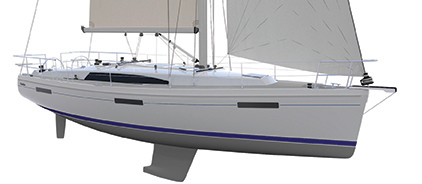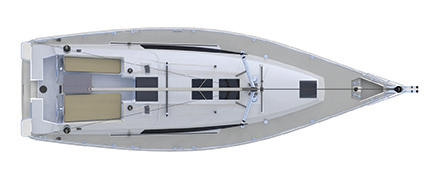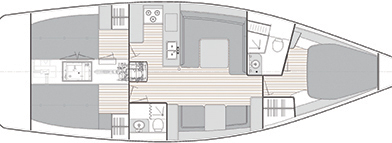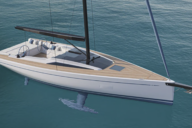Catalina Yachts—America’s leading builder of production sailboats—introduces their all new Catalina 425, and while still built to the high standards of the whole Catalina line, the new boat is definitely a refreshing new take on what a mid-sized family cruisers can be.
Catalina’s chief designer Gerry Douglas noted that “The 425 is designed to be a wholesome, American-built, three-cabin family cruising boat that is intended for generations of use and to hold its value well over time.”
Catalina is no stranger to building boats that become the best sellers in their class. For example, the company built 2,305 of their famous 36s and 1,022 of the classic 42s. The launch of the 275 two years ago marked a new modern design phase for the company and the 425 continues that tradition with completely modern lines and many well proven and well thought out details.

The hull has a nine degree bow that is nearly plumb but angled forward just enough to keep the foredeck dry while beating to windward and to keep the anchor from dinging the bow’s gel coat when it is being hoisted on deck. The stern has a modest sugar scoop and a door that leads into the cockpit, which keeps the cockpit secure when underway but allows for easy access to the stern.
The cockpit is large and commodious, with twin wheels and bench seats long enough to lie on. The side decks going forward are wide and with the chainplates for the rig mounted inboard next to the cabin sides, you don’t have to duck or turn sideways to get to the foredeck. The anchor locker is huge and equipped with an electric windlass, which makes anchoring —and re-anchoring—so much easier.
The rig shown in the drawings is a tall sloop configuration with an in-mast roller furling mainsail and a roller furling 100-percent jib. The jib is self tacking and fitted with its own traveler. All of the sheets and the furling line for the jib are led aft to the helms so the boat can be effectively singlehanded.

The 425 has a short bowsprit that has two bow rollers for anchors and doubles as the tacking point for a downwind sail such as a screecher or an asymmetrical reacher on a top-down furler. The added horsepower in these downwind sails that can be left hoisted all the time will make sailing the 425 a blast.
Fitting a three-cabin accommodation plan into a 42-foot cruising boat that also has two heads and an aft sea-going galley is no small feat but it looks like Douglas has done just that. He noted, “The three cabin version of our classic 42 did not have an aft galley and many owners suggested that they would prefer that to an in-line galley. So, our goal was to create a new accommodation plan that offers three cabins, a large and comfortable owner’s cabin forward, two heads and the after galley. The galley is a true offshore galley so cooking while on the move will be more convenient and, I think, safer. The forward cabin has a large centerline double berth that is one of the largest berths on a cruising boat and appropriate for sailors over six feet tall.”
The 425 has a number of design features that will give her owners confidence. In the bow, the boat has what Catalina calls their “Strike Zone” collision bulkhead that will protect the hull’s integrity should it run over a container or other hard objects at sea. The rudder has the “Deep Defense” system that will sustain a collision and keep on steering. The mast is deck stepped and mounted on Catalina’s “T-Beam Mast Step” that transfers all compression to the top of the keel and main bulkhead while also providing all of the benefits of a deck-stepped mast.
Douglas developed a new hull-to-deck joint system in the 275 design process and has adapted that to the 425. “The new joint,” he said, “provides a large and secure flange to attach the deck to the hull and allows us to eliminate the aluminum toe rail that to my eye looks a bit dated in today’s market. The new molded toe rails look better and are a lot more watertight and stronger.”
Catalina still uses lead keels on their boats and the 425 is no exception. Lead is denser than cast iron and absorbs a grounding much better. A lead keel enhances stability and has allowed Douglas to give the new boat a very high—40 percent—ballast-to-displacement ratio, which is a good indication of the boat’s stability and stiffness when sailing in a breeze.

The other non-dimentional ratios also tell us a lot about the new design. The displacement length ratio is 130, which indicates that the boat is relatively light and has been built with excellent sailing performance at the top of the list. The sail area-to-displacement ratio of 21 indicates that the power in the sail plan is relatively high, again an indication of the boat’s speed potential.
With a long waterline and good performance ratios, the 425 should be one of Catalina’s best performing cruisers. The boat is built to the highest ABYC and IMI standards and has a Category A—unlimited offshore—rating.
As soon as hull number one is launched and ready to sail, BWS will give the boat a full sea trial for a complete review in a future issue. For more information, log on to www.catalinayachts.com.
Specification:
LOA 41’8”
LWL 39’1”
Beam 13’8”
Draft 6’8” (std.)
or 4’11”(shoal)
Ballast 7,000 lbs.
Displ. 17,500 lbs.
Water 114 gals.
Fuel 65 gals.
Waste 54 gals.












